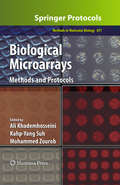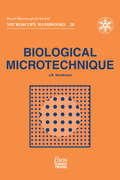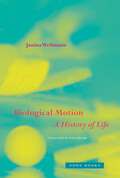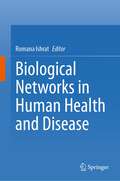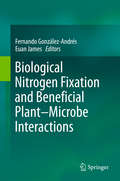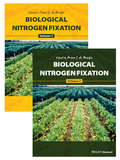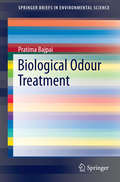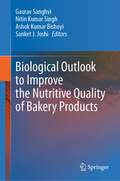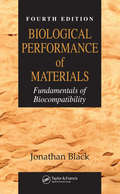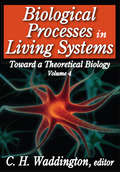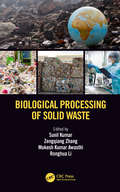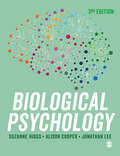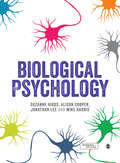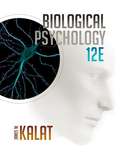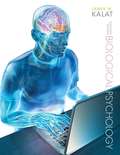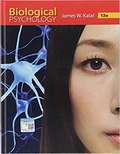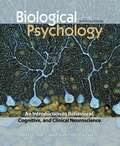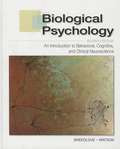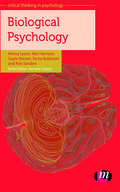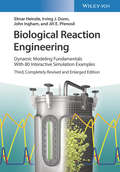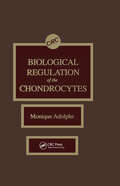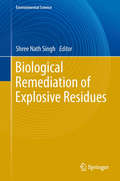- Table View
- List View
Biological Microarrays: Methods and Protocols (Methods in Molecular Biology #671)
by Mohammed Zourob Kahp-Yang Suh Ali KhademhosseiniRecent developments in microarray technology have changed the landscape of biology and biomedical research, and they have revolutionized RNA and DNA research. In Biological Microarrays: Methods and Protocols, expert researchers explore exciting new developments in the field, providing a comprehensive approach to biological microarrays that conveys not only the state-of-the-art fundamentals, but also includes applications of the most innovative methods. Chapters address both the application of biological microarrays, including DNA/RNA, apatmer, proteins, tissues, oligonucleotides, carbohydrates, biomaterials, cells, bacteria, and virus microarrays, and also explore the different techniques used for generating microarray platforms. Composed in the highly successful Methods in Molecular BiologyTM series format, each chapter contains a brief introduction, step-by-step methods, a list of necessary materials, and a Notes section which shares tips on troubleshooting and avoiding known pitfalls. Wide-ranging and revolutionary, Biological Microarrays: Methods and Protocols serves as a primary source for academics, practitioners, and professionals in related fields, including biologists, biotechnologists, biochemists, analytical chemists, and biomedical, physical, and microsystems engineers, to name a few, appealing to all of those interested in the present and future state of biological microarray research.
Biological Microtechnique
by Jeremy SandersonA completely new practical guide to both new and classical methods of slide-making which is easy-to-read and easy-to-understand. Biological Microtechnique contains a wealth of practical detail which will provide a firm grounding in preparative methods for light microscopy.
Biological Motion: A History of Life
by Janina WellmannA captivating exploration of the changing definitions of life in biologyBiological Motion studies the foundational relationship between motion and life. To answer the question, &“What is Life?,&” prize-winning historian of science Janina Wellmann engages in a transdisciplinary investigation of motion as the most profound definition of living existence.For decades, information and structure have dominated the historiography of the life sciences with its prevailing focus on DNA structure and function. Now more than ever, motion is a crucial theme of basic biological research. Tracing motion from Aristotle&’s animal soul to molecular motors, and from medical soft robotics to mathematical analysis, Wellmann locates biological motion at the intersection of knowledge domains and scientific and cultural practices. She offers signposts to mark the sites where researchers, technologies, ideas, and practices opened up new paths in the constitution of the phenomenon of motion. An ambitious rethinking of the life sciences, Biological Motion uncovers the secret life of movement and offers a new account of what it means to be alive.
Biological Networks in Human Health and Disease
by Romana IshratThis book presents methods and tools of network biology and bioinformatics for understanding the disease dynamics and identification of drug targets. The initial section of chapters introduce the theoretical aspects followed by the different applications for construction and analysis of biological networks, methods for identifying crucial nodes in networks, and network dynamics. The book covers the latest advances in the network medicine, exploring the different types of biological networks, and their applications. It further reviews the role of R language in the network-based approaches that help in understanding biological systems and identifying biological functions. Towards the end, the book explores the recent developments and applications in machine learning and its potential for advancing network biology. Finally, the book elucidates a comprehensive yet a representative description of challenges associated with the understanding of disease dynamics using network biology. Given its scope, the book is intended for researchers and advanced postgraduate students of bioinformatics, computational biology, and medical sciences.
Biological Nitrogen Fixation and Beneficial Plant-Microbe Interaction
by Fernando González-Andrés Euan JamesThis book covers the most recent advances in all the topics with which researchers and professionals need to be familiar in order to obtain a better understanding of, and to better exploit, beneficial plant-microbe interactions. The use of microorganisms for agriculture and environmental applications is gaining importance worldwide to improve crop performance, but also for other environmental applications, such as bioremediation in chemically polluted soils. The search for an equilibrium between fundamental and applied aspects makes this book useful for professionals at various levels in the value chain of the "microbial biofertilizers". Challenges of comercializing biofertilizers involve efficiency of the products and safety for human health and the environment, topics that have paid central attention in this book. Students, scientists and biofertilizers developers will find updated and comprehensive information about the different aspects to be considered to address a successful introduction of biofertilizers in sustainable agriculture and environmental actions.
Biological Nitrogen Fixation, 2 Volume Set
by Frans J. de BruijnNitrogen is arguably the most important nutrient required by plants. However, the availability of nitrogen is limited in many soils and although the earth's atmosphere consists of 78.1% nitrogen gas (N2) plants are unable to use this form of nitrogen. To compensate , modern agriculture has been highly reliant on industrial nitrogen fertilizers to achieve maximum crop productivity. However, a great deal of fossil fuel is required for the production and delivery of nitrogen fertilizer. Moreover carbon dioxide (CO2) which is released during fossil fuel combustion contributes to the greenhouse effect and run off of nitrate leads to eutrophication of the waterways. Biological nitrogen fixation is an alternative to nitrogen fertilizer. It is carried out by prokaryotes using an enzyme complex called nitrogenase and results in atmospheric N2 being reduced into a form of nitrogen diazotrophic organisms and plants are able to use (ammonia). It is this process and its major players which will be discussed in this book. Biological Nitrogen Fixation is a comprehensive two volume work bringing together both review and original research articles on key topics in nitrogen fixation. Chapters across both volumes emphasize molecular techniques and advanced biochemical analysis approaches applicable to various aspects of biological nitrogen fixation. Volume 1 explores the chemistry and biochemistry of nitrogenases, nif gene regulation, the taxonomy, evolution, and genomics of nitrogen fixing organisms, as well as their physiology and metabolism. Volume 2 covers the symbiotic interaction of nitrogen fixing organisms with their host plants, including nodulation and symbiotic nitrogen fixation, plant and microbial "omics", cyanobacteria, diazotrophs and non-legumes, field studies and inoculum preparation, as well as nitrogen fixation and cereals. Covering the full breadth of current nitrogen fixation research and expanding it towards future advances in the field, Biological Nitrogen Fixation will be a one-stop reference for microbial ecologists and environmental microbiologists as well as plant and agricultural researchers working on crop sustainability.
Biological Oceanography
by Eric MillsFirst published in 1989, Eric L. Mills's comprehensive history of biological oceanography has been praised as 'superb' (BioScience) and 'proof that history need not be dull' (The Northern Mariner). This first history of the field, which chronicles the scientific work and creativity of its chief contributors, tells a riveting story that is far from narrowly scientific and thoroughly accessible to general readers. Mills shows how the work and ideas of the main actors are inseparable from some seemingly unrelated factors, including Prussian imperialism, agricultural chemistry, microbiology, and the problems of German universities. Mills also illustrates the significant roles played in the field's development by the failures of commercial fisheries, the development of analytical chemistry, the establishment of international scientific organizations, and sheer scientific curiosity.This new edition of Biological Oceanography includes a fresh introduction by the author, as well as an original foreword by noted oceanographer John Cullen. It makes an excellent companion to Mills's recent history of mathematical and physical oceanography, the multi-award-winning and widely acclaimed The Fluid Envelope of Our Planet.
Biological Odour Treatment (SpringerBriefs in Environmental Science)
by Pratima BajpaiShowcasing the very latest technologies for neutralising the unpleasant--and sometimes dangerous--odours from industrial and waste management processes, this Springer Brief in Environmental Sciences covers physical, chemical and biological methods. The volume includes modern biotechnological approaches now making it cost-effective to tackle malodorous chemicals at very small concentrations. The book reflects the fact that odour affects us in several ways, which range from compromising our quality of life to causing respiratory and other unpleasant conditions and from depressing property values to severe health problems caused by the toxic stimulants of odours. Innumerable industrial processes release malodourous and harmful vapours. The human sense of smell can detect some noxious chemicals, such as the sulphurous by-products of paper manufacturing, at concentrations of one part per billion. This e-book shows what has been achieved in combating offensive and harmful odours. While conventional air pollution control technologies can treat a wide variety of pollutants at higher concentrations, the chapters cover the more refined biological methods used to deal with odours and volatile organic compounds in low concentrations. These include bio scrubbers and bio trickling filters. Standing alongside its detailed discussion of the health impacts of total reduced sulphur compounds, and the composition of paper pulp industry emissions, this publication offers comprehensive and in-depth treatment of some of the most potent anti-odour technologies yet devised.
Biological Outlook to Improve the Nutritive Quality of Bakery Products
by Nitin Kumar Singh Sanket J. Joshi Gaurav Sanghvi Ashok Kumar BishoyiThis book aims to bring the focus on biological viewpoint and alternatives for producing the baked goods, as the confectionary is a major market segment comprising of the sugar and baked products. The bakery products include major segments including cereals, bread, chocolates, cookies, and other confectionary items. This book provides the data regarding the market of baked goods, as it is forecasted to increase at growth rate of 5.8% (CAGR) and it’s expected to reach around its growth around (7%) by 2025 (Fortune insights 2022). The book also classifies amongst the major consumers worldwide, Asia pacific contributes around 43%, western Europe contributes around 22% while Africa continent represents as smallest group of consumers for baked confectionary consumers. The book provides information regarding health concerns as baked goods are liked by population of all ages. As per the data mentioned above the bakery goods are consumed heavily without clear insights about its health concerns. Majority of baked goods are made up of all-purpose flour having serious risk concerns/impact on health and higher consumption of bakery goods can increase sugar, cholesterol level and can also cause further problem in liver or heart functions. Although, gluten free, multigrain baked confectionaries are now a day’s available in the market but the still the better understanding of the bio-based products is need of current time. The biological viewpoint especially for the bakery goods can serve as initial point for better handling baked goods in context of upbringing of healthy society. The book targets students and researchers interested in interdisciplinary research and devising novel biological applications with special focus on bakery products.
Biological Performance of Materials: Fundamentals of Biocompatibility, Fourth Edition
by Jonathan BlackBioengineers need a thorough grounding in biocompatibility - the biological performance of materials. Until now, there were no publications suitable for a neophyte in the field; prior publications were either not comprehensive or focused on rather narrow interests. Drawing on the author's 35 years of experience as a teacher, researcher, and consult
Biological Processes in Living Systems: Toward A Theoretical Biology (Toward a Theoretical Biology)
by C. H. WaddingtonBiological Processes in Living Systems is the fourth and final volume of the Toward a Theoretical Biology series. It contains essays that deal in detail with particular biological processes: morphogenesis of pattern, the development of neuronal networks, evolutionary processes, and others. The main thrust of this volume brings relevance to the general underlying nature of living systems. Faced with trying to understand how the complexity of molecular microstates leads to the relative simplicity of phenome structures, Waddington-on behalf of his colleagues-stresses on the structure of language as a paradigm for a theory of general biology. This is language in an imperative mood: a set of symbols, organized by some form of generative grammar, making possible the conveyance of commands for action to produce effects on the surroundings of the emitting and the receiving entities. "Biology," he writes, "is concerned with algorithm and program." Among the contributions in this volume are: "The Riemann-Hugoniot Catastrophe and van der Waals Equation," David H. Fowler; "Differential Equations for the Heartbeat and Nerve Impulse," E. Christopher Zeeman; "Structuralism and Biology," Rene Thom; "The Concept of Positional Information and Pattern Formation," Lewis Wolpert; "Pattern Formation in Fibroblast Cultures," Tom Elsdale; "Form and Information," C. H. Waddington; "Organizational Principles for Theoretical Neurophysiology," Michael A. Arbib; "Stochastic Models of Neuroelectric Activity," Jack D. Cowan. Biological Processes in Living Systems is a pioneering volume by recognized leaders in an ever-growing field.
Biological Processing of Solid Waste
by Sunil Kumar, Zengqiang Zhang, Mukesh Kumar Awasthi, and Ronghua LiOffering a comprehensive approach, this title covers fundamentals, technologies, and management of biological processing of solid waste. It discusses kinetic modeling and synergistic impact evolution during bioprocessing of solid waste, environmental impacts such as greenhouse gas emission from biological processing of solid waste, energy recovery from solid waste, and biodrying of solid waste. It also presents cases and challenges from different countries, successful business models, and economic analyses of various processing options. Aimed at researchers and industry professionals in solid and hazardous waste management, this title offers a wealth of knowledge to help readers understand this increasingly important area.
Biological Psychology
by Jonathan Lee Suzanne Higgs Alison CooperBiological Psychology offers a highly visual, in-depth guide to the basic biological functions of the brain that you will need to learn throughout the course of your psychology degree. This edition boasts a revamped learning structure with a strong applied focus. This allows you to engage with biological psychology through a range of real world applications, getting you to apply your learning to conditions such as epilepsy, PTSD and Parkinson’s, and treatments such as gene therapy and brain-computer interfaces for spinal cord injuries. Key features include: • New ′real world applications′ boxes that help put theory into practice, showing you the human side of the science • ′Focus on methods′ boxes that demonstrate the research methods you will use as a biological psychologist to uncover the workings of the brain • Key debates to deepen your understanding of contemporary research and its impact • Critical thinking questions • Key points and glossary definitions to solidify your understanding of complex ideas and new terminology • Further reading suggestions to help build your bibliography for assignments • Video animations to help you grasp basic neuroanatomy and psychobiology This book goes above and beyond to familiarise you with the links between biology and psychology, making it an essential read for psychology students at all levels. Suzanne Higgs is Professor in the Psychobiology of Appetite at the University of Birmingham. Alison Cooper is a Senior Lecturer at the University of Birmingham. Jonathan Lee is Professor of Memory Neuroscience at the University of Birmingham.
Biological Psychology
by Jonathan Lee Suzanne Higgs Alison CooperBiological Psychology offers a highly visual, in-depth guide to the basic biological functions of the brain that you will need to learn throughout the course of your psychology degree. This edition boasts a revamped learning structure with a strong applied focus. This allows you to engage with biological psychology through a range of real world applications, getting you to apply your learning to conditions such as epilepsy, PTSD and Parkinson’s, and treatments such as gene therapy and brain-computer interfaces for spinal cord injuries. Key features include: • New ′real world applications′ boxes that help put theory into practice, showing you the human side of the science • ′Focus on methods′ boxes that demonstrate the research methods you will use as a biological psychologist to uncover the workings of the brain • Key debates to deepen your understanding of contemporary research and its impact • Critical thinking questions • Key points and glossary definitions to solidify your understanding of complex ideas and new terminology • Further reading suggestions to help build your bibliography for assignments • Video animations to help you grasp basic neuroanatomy and psychobiology This book goes above and beyond to familiarise you with the links between biology and psychology, making it an essential read for psychology students at all levels. Suzanne Higgs is Professor in the Psychobiology of Appetite at the University of Birmingham. Alison Cooper is a Senior Lecturer at the University of Birmingham. Jonathan Lee is Professor of Memory Neuroscience at the University of Birmingham.
Biological Psychology
by Mike Harris Dr Suzanne Higgs Dr Jonathan H. Lee Dr Alison CooperWritten to guide undergraduate students new to brain and behaviour through the key biological concepts that determine how we act, Biological Psychology provides a comprehensive introduction to the subject. It includes detailed coverage of sensation, movement, sleep, eating and emotions, with further chapters on the biological basis of psychological disorders and the effects of drug-taking. Uniquely, the authors emphasize the importance of learning and memory as a key thread throughout and include advanced chapters on key research areas that push discussion further and encourage critical thinking, making this book appropriate for undergraduates studying biological psychology at any level. Key features include: ‘Spotlights’ offering insights into key areas of research that expose the most important developing issues in the field today A clear structure including roadmaps and key points for each chapter to ease navigation through the book and understanding of the links between concepts Full colour presentation to bring the topics to life through clear and comprehensive illustrations and diagrams A companion website at study.sagepub.com/higgs with a range of materials for instructors and students
Biological Psychology
by Mike Harris Dr Suzanne Higgs Dr Jonathan H. Lee Dr Alison CooperWritten to guide undergraduate students new to brain and behaviour through the key biological concepts that determine how we act, Biological Psychology provides a comprehensive introduction to the subject. It includes detailed coverage of sensation, movement, sleep, eating and emotions, with further chapters on the biological basis of psychological disorders and the effects of drug-taking. Uniquely, the authors emphasize the importance of learning and memory as a key thread throughout and include advanced chapters on key research areas that push discussion further and encourage critical thinking, making this book appropriate for undergraduates studying biological psychology at any level. Key features include: 'Spotlights' offering insights into key areas of research that expose the most important developing issues in the field today A clear structure including roadmaps and key points for each chapter to ease navigation through the book and understanding of the links between concepts Full colour presentation to bring the topics to life through clear and comprehensive illustrations and diagrams A companion website at study.sagepub.com/higgs with a range of materials for instructors and students
Biological Psychology
by James W. KalatDr. James W. Kalat's BIOLOGICAL PSYCHOLOGY is widely used for good reason: an extremely high level of scholarship, a clear writing style with amusing anecdotes, and precise examples. Kalat's goals are to make biological psychology accessible and to convey the excitement of the search for biological explanations of behavior, and he delivers. Updated with new topics, examples, and recent research findings, the new 12th edition continues this book's tradition of quality.
Biological Psychology (Eleventh Edition)
by James W. KalatThe most widely used text in its course area, Dr. James W. Kalat's BIOLOGICAL PSYCHOLOGY appeals to students and instructors alike. Throughout all eleven editions, the goal has been to make biological psychology accessible to psychology students, not just to biology majors and pre-meds. The goal has also been to convey the excitement of the search for biological explanations of behavior. Kalat believes that biological psychology is "the most interesting topic in the world," and this text convinces many students--and perhaps you, too--with its clear writing style, amusing anecdotes, and intriguing examples. A media-rich, highly interactive online eBook integrates the text with videos, animations, and an online bio-lab component, making it easier for you to learn.
Biological Psychology (Mindtap)
by James KalatThe most widely used text in its course area, James W. Kalat's BIOLOGICAL PSYCHOLOGY has appealed to thousands of students before you. Why? Kalat's main goal is to make Biological Psychology understandable to Psychology students, not just to Biology majors and pre meds--and he delivers. Another goal is to convey the excitement of the search for biological explanations of behavior. Kalat believes that Biological Psychology is "the most interesting topic in the world," and this text convinces many students--and maybe you, too--with clear writing, amusing anecdotes and intriguing examples. MindTap, an interactive online learning resource that integrates the text with videos, animations and a virtual bio-lab component, makes learning even easier and more enjoyable.
Biological Psychology: An Introduction to Behavioral and Cognitive Neuroscience
by S. Marc Breedlove Mark R. Rosenzweig Neil V. WatsonBiological Psychology is a comprehensive survey of the biological bases of behavior that is authoritative and up-to-date. Designed for undergraduates enrolled in Biological Psychology, Physiological Psychology, or Behavioral Neuroscience, the book continues to offer an outstanding illustration program that engages students, making even complicated topics and processes clear. It offers a broad perspective, encompassing lucid descriptions of behavior, evolutionary history, development, proximate mechanisms, and applications. The Sixth Edition features a thoroughly redesigned and up-to-date Cognitive Neuroscience module (Part VI; Chapters 17-19), with expanded coverage of attention, executive control, and decision-making processes, in keeping with the latest research breakthroughs. Optional advanced topics are available on the Web as "A Step Further," streamlining the printed text to emphasize the important points. The new edition boasts hundreds of new references, including research students may have encountered in the popular media. Yet critical thinking skills are also honed as the reader is alerted to the many widely held myths about the neuroscience of behavior and educated about facts that sound unlikely to the uninformed. Thorough and reader-friendly, Biological Psychology reveals the fascinating interactions of brain and behavior. KEY FEATURES * The book has an outstanding full-color art program, including hundreds of original illustrations that make it easy to understand structures, mechanisms, and processes in the brain. * Each chapter opens with a brief outline and a narrative illustrating an important aspect of behavioral biology that will be made clear to the student by reading the rest of the chapter. * Redesigned chapter summaries are organized by main chapter heads in a readable two-column format. Each has bold-faced key terms, callouts to pertinent figures, and references to the Companion Website.
Biological Psychology: An Introduction to Behavioral, Cognitive, and Clinical Neuroscience, Seventh edition
by S. Marc Breedlove Neil V. WatsonBiological Psychology, Seventh Edition is a comprehensive survey of the biological bases of behaviour designed for undergraduates enrolled in biological psychology, physiological psychology, or behavioural neuroscience courses. It offers a broad perspective, encompassing lucid descriptions of behaviour, evolutionary history, development, proximate mechanisms, and applications.
Biological Psychology: Learning Through Assessment (Critical Thinking in Psychology Series)
by Minna Lyons Sarita Robinson Neil Harrison Gayle Brewer Robert L. SandersThis accessible introductory text addresses the core knowledge domain of biological psychology, with focused coverage of the central concepts, research and debates in this key area. Biological Psychology outlines the importance and purpose of the biological approach and contextualises it with other perspectives in psychology, emphasizing the interaction between biology and the environment. Learning features including case studies, review questions and assignments are provided to aid students′ understanding and promote a critical approach. Extended critical thinking and skill-builder activities develop the reader′s higher-level academic skills.
Biological Reaction Engineering: Dynamic Modeling Fundamentals with 80 Interactive Simulation Examples
by Elmar Heinzle John Ingham Irving J. Dunn Jiří E. PřenosilThis practical book presents the modeling of dynamic biological engineering processes in a readily comprehensible manner, using the unique combination of simplified fundamental theory and direct hands-on computer simulation. The mathematics is kept to a minimum, and yet the 60 examples illustrate almost every aspect of biological engineering science, with each one described in detail, including the model equations. The programs are written in the modern user-friendly simulation language Berkeley Madonna, which can be run on both Windows PC and Power-Macintosh computers. Madonna solves models comprising many ordinary differential equations using very simple programming, including arrays. It is so powerful that the model parameters may be defined as "sliders", which allow the effect of their change on the model behavior to be seen almost immediately. Data may be included for curve fitting, and sensitivity or multiple runs may be performed. The results can be viewed simultaneously on multiple-graph windows or by using overlays. The examples can be varied to fit any real situation, and the suggested exercises provide practical guidance. The extensive teaching experience of the authors is reflected in this well-balanced presentation, which is suitable for the teacher, student, biochemist or the engineer.
Biological Regulation of the Chondrocytes
by Monique AdolpheBiological Regulation of the Chondrocytes provides a comprehensive examination of the various regulations in which cartilaginous cells are involved. The book's introductory chapter provides an overview of the different types of chondrocyte, while following chapters discuss the various biological regulations implicated in chondrocyte functions, especially the modulation of differentiative properties. Chapters 2 and 3 examine the extracellular matrix components, and Chapter 4 discusses the special case of cultured chondrocytes and the usefulness of in vitro approaches. The following three chapters focus on the complex role of cartilaginous growth factors and cytokines (FGF, TGFB, IGF, and IL1) on the modulation of the chondrocyte properties. Chapter 9 discusses the synoviocyte, and the last four chapters examine the biochemical and molecular perturbations that appear during repair, aging, rheumatic disease, and cancer. Biological Regulation of the Chondrocytes will benefit rheumatologists, pharmaceutical researchers, physiologists, connective tissue specialists, and students and other researchers in the osteoarticular field.
Biological Remediation of Explosive Residues (Environmental Science and Engineering)
by Shree Nath SinghMicrobial degradation, Phytoremediation, Remediation, Explosive residues, Biotransformation, Mineralization, Degradative Enzymes, Degradation Pathways, Energetics, Soil contamination, Water contamination.
